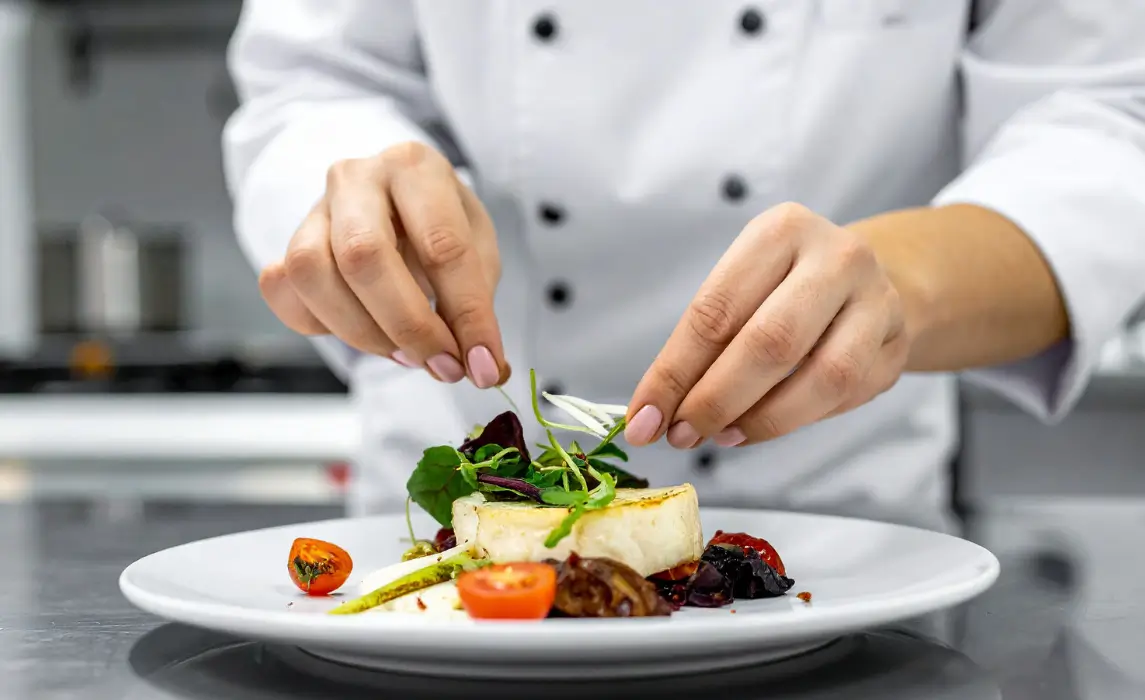Food plating and presentation combine the artistry of design with the science of sensory perception. It’s more than decoration—it’s the bridge between taste and visual experience. Before we even take a bite, our brain begins evaluating the dish through sight. A well-plated meal can influence how we perceive flavor, freshness, and quality. In both professional and home kitchens, thoughtful presentation transforms ordinary food into a memorable experience. It reflects the chef’s creativity, discipline, and respect for the ingredients while evoking emotion and curiosity in the diner.
The Importance of Presentation in Dining
Plating is often described as the “silent language” of cooking. It communicates a chef’s personality, culinary style, and attention to detail. Whether in fine dining, casual settings, or social media posts, how food is presented affects how we value it. Studies have shown that diners are willing to pay more for dishes that look appealing, even when the ingredients are identical. Presentation shapes our expectations—smooth sauces, crisp edges, and harmonious colors signal freshness and care, while clumsy arrangement or poor contrast can dampen excitement before the first taste.
On social media platforms like Instagram or Pinterest, food presentation has also become a form of storytelling. It allows chefs, home cooks, and creators to share culture, technique, and passion visually. A well-plated dish not only entices appetite but also creates a connection between the maker and the audience.
Core Principles of Food Plating
Balance and Harmony
A balanced plate creates both visual and culinary satisfaction. This includes the right ratio of protein, starch, and vegetables, as well as a balance of color, texture, and shape. For example, pairing a crisp salad with a creamy puree or a seared crust with a smooth sauce keeps the palate and eyes engaged. Negative space—empty areas on the plate—plays a vital role too. It provides breathing room for the main components, preventing overcrowding and enhancing focus.
Focal Point
Every dish needs a “hero.” It’s the element you want diners to notice first, such as a perfectly cooked steak or a delicate piece of fish. Supporting ingredients—sauces, vegetables, or garnishes—should draw attention to the hero without overpowering it. Strategic placement, like centering the focal point or framing it with smaller components, directs the viewer’s gaze naturally.
Proportion and Scale
Components should complement each other in size and volume. Large items should not overshadow smaller ones, and sauces should enhance, not drown, the plate. Proper portioning also ensures practicality; diners should be able to enjoy each bite without struggling with oversized elements.
Movement and Flow
An effective plate leads the eye in a smooth direction, often following an invisible curve or diagonal line. Using swooshes of sauce or angled arrangements adds dynamic flow, while rigid symmetry can sometimes feel lifeless. Organic movement makes a plate more engaging, evoking a sense of motion and vitality.
Ingredient Integrity
Aesthetic manipulation should never compromise taste or texture. Let ingredients maintain their natural shapes when possible—perfectly roasted carrots or vibrant leafy greens have their own visual charm. Over-processing can make a dish feel artificial, while showcasing authenticity emphasizes freshness and quality.
Read Related Article: Easy New Years Eve Drinks and Cocktails: Simple Recipes for a Festive Celebration
Ring in the New Year with style using these easy drink and cocktail recipes. Discover simple, festive mixes—from sparkling champagne cocktails to colorful mocktails—that make your celebration unforgettable.
Read More
Tools and Materials for Professional Plating
The plate is a canvas, and choosing the right one enhances the artistry. White plates are timeless, providing a neutral background that lets colors shine. Dark or matte plates create drama, while colored ceramics can reinforce a theme or mood. Beyond the plate, the right tools bring precision and consistency.
- Tweezers and plating tongs allow chefs to position delicate herbs or petals with care.
- Ring molds create uniformity for grains, rice, or layered salads.
- Squeeze bottles and brushes control sauce placement, adding both accuracy and artistry.
- Microplanes and graters add fine garnishes like zest or cheese dust, offering aroma and texture.
- Cloths and sponges ensure clean plate edges—a small detail that elevates professionalism.
Even lighting and backdrop considerations play a role, especially for those photographing food for menus or online content. Natural light, minimal shadows, and clear color contrast can make a dish look vibrant and appetizing.
Color, Texture, and Storytelling Through Food
Plating is an opportunity to tell a story through color and composition. Each dish can represent a season, a cultural identity, or an emotion. For instance, a bright, citrus-based dish with greens and yellows feels summery and refreshing, while warm tones of orange, brown, and gold suggest autumn comfort.
Textures add another dimension to this story. Combining soft, crispy, and crunchy elements creates variety both visually and on the palate. A drizzle of glossy sauce beside a matte puree or a delicate foam next to a crisp chip enhances sensory complexity.
Flavor storytelling also matters. A spicy element can symbolize boldness, while a delicate floral garnish communicates elegance. Chefs often draw inspiration from nature—mimicking landscapes, waves, or gardens—to make a dish not just edible but experiential.
Practical Workflow and Plating Efficiency
Behind a beautiful plate is a disciplined workflow. Plating requires timing, coordination, and attention to temperature. Before starting, visualize your layout—some chefs even sketch it out. Prepare components in advance (mise en place) to ensure that the plating process is smooth and swift.
When assembling:
- Start with the base or starch.
- Add the main protein or hero element.
- Layer supporting sides strategically.
- Finish with sauces, then garnishes last to maintain freshness.
Temperature is critical. Cold ingredients should go on first, hot components last, ensuring the final plate reaches the table at the right warmth. Wipe the edges for cleanliness, inspect under bright light, and check from multiple angles before serving. The difference between “good” and “exceptional” presentation often lies in these final few seconds.
Common Mistakes and How to Avoid Them
Even skilled cooks fall into common plating traps. Overcrowding the plate can confuse the eye and diminish elegance. Avoid making every element symmetrical—intentional asymmetry adds character. Garnishes should always serve a purpose; decorative parsley with no flavor contribution feels outdated and meaningless. Ensure colors contrast naturally—too many similar tones make a plate appear flat.
Temperature mishandling is another major issue. Sauces that cool too quickly congeal and lose shine, while overcooked vegetables wilt under warm lights. Always check that each component is plated at its ideal temperature and consistency. Simplicity, precision, and intention are the ultimate antidotes to chaos.
Read Related Article: What is a Charger Plate Used for: Enhancing Table Settings
Discover the purpose of a charger plate and how it elevates your dining experience. Learn how to use charger plates to enhance table settings, add elegance, and create a polished, professional look for any occasion.
Read More
Adapting Plating Styles to Context
Different dining environments call for different approaches. In fine dining, precision and restraint rule—minimalist compositions, micro-garnishes, and modern geometric layouts dominate. In casual or family-style dining, warmth and generosity are key; rustic arrangements and layered comfort foods invite sharing.
For buffets and catering, uniformity and durability matter more than delicate beauty. Components must remain attractive even after standing for long periods. Meanwhile, for social media plating, the goal shifts toward visual storytelling. Angled shots, layered elements, and vivid contrasts photograph well under natural light.
Respecting cultural authenticity is also essential. A traditional Japanese bento, an Italian antipasto, or a Filipino adobo carries its own plating language. Modern reinterpretation can be creative, but it should never erase cultural integrity.
Developing Your Personal Plating Style
Improving presentation is a continuous learning process. Study color theory, observe the work of professional chefs, and experiment with everyday ingredients. Take photographs of your plates to evaluate symmetry, flow, and light distribution. Challenge yourself by plating the same dish in multiple ways—minimalist, rustic, avant-garde—and assess which best conveys the mood you want.
Feedback from others is invaluable. Ask diners or peers what caught their attention first, what felt natural, and what distracted them. Over time, you’ll develop a signature aesthetic—a personal language that speaks through your food.
The Lasting Impact of Food Presentation
A beautifully plated dish does more than please the eyes—it creates an emotional imprint. It makes the diner feel valued and transforms eating into a sensory journey. Good presentation doesn’t have to be complex; it simply needs to be thoughtful. It’s about expressing respect for the ingredients, the craft, and the person who will enjoy the meal.
In essence, food plating and presentation are the culmination of creativity, balance, and discipline. It’s where culinary skill meets design thinking. When every color, shape, and texture harmonizes, food transcends nourishment—it becomes art that tells a story, invites curiosity, and lingers long after the final bite.
Frequently Asked Questions (FAQs)
Food plating and presentation involve more than arranging ingredients—they reflect creativity, precision, and care. These frequently asked questions offer practical insights to help you refine your technique, maintain visual appeal, and create dishes that look as amazing as they taste.
1. How do lighting and background affect the appearance of plated food?
Lighting dramatically influences how colors and textures appear. Natural light is ideal because it brings out the food’s true tones and highlights depth without distortion. Warm indoor lights can make food appear richer, while cool lighting may flatten or dull colors. Background choice also plays a role—neutral or matte surfaces (like wood or stone) enhance contrast and keep the focus on the food. Avoid overly bright or patterned backdrops that compete for attention.
2. What’s the best way to practice food plating at home without professional tools?
Start small and use what you already have. Experiment with different plate shapes, portions, and simple tools like spoons or zip-top bags to drizzle sauces. Try arranging ingredients in layers or creating natural height using everyday items like cups or cookie cutters. Taking photos of your attempts helps you evaluate composition, symmetry, and color contrast. Over time, your sense of balance and creativity will sharpen even without restaurant-grade equipment.
3. How can I make plated dishes stay visually appealing for photography or serving delays?
To maintain freshness, avoid plating overly moist ingredients too early—liquids can spread and ruin presentation. Keep delicate items like herbs and microgreens chilled until the last minute, and lightly brush proteins or vegetables with oil or glaze to keep them glossy. For photos, use a cool environment to prevent wilting and prepare backups of key components in case they lose texture. Timing and environmental control are as important as technique for picture-perfect presentation.







